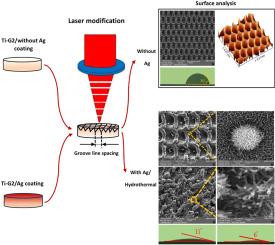Formation of hierarchical micro/nanostructures of Ag/sodium titanate on grade 2 titanium via hybrid laser/hydrothermal processing
IF 4.7
3区 材料科学
Q2 MATERIALS SCIENCE, MULTIDISCIPLINARY
引用次数: 0
Abstract
Nowadays, titanium implants with multi-scale surface geometries exhibiting biomimetic and antibacterial properties have garnered significant attention due to their potential to enhance osteoconduction and osseointegration. Although titanium is inherently bioinert, surface modification has transformed it into one of the most biocompatible materials for implants. This study aimed to create and characterize a multi-scale geometric surface on grade 2 titanium samples, simultaneously alloyed with silver, using a hybrid laser/hydrothermal process. The effects of laser parameters on surface morphology, roughness, and wettability were evaluated for both surface-alloyed and unalloyed samples. The results showed that laser treatment created regular micrometer-scale structures with controllable silver incorporation. Subsequent hydrothermal treatment further modified the surface by forming a nanoscale Ag/sodium titanate structure on the laser-induced micro-roughness, significantly enhancing wetting behavior and resulting in a superhydrophilic surface. Moreover, increasing the laser groove line spacing altered the surface micro/nanostructure morphology, leading to the formation of a silkworm-like titanate structure. Additionally, the Sq and Sa roughness parameters decreased with increasing laser groove line spacing, while Ssk < 0 and Sku < 3 values were obtained, potentially contributing to long-term surface wettability.

激光/水热复合工艺在2级钛上形成银/钛酸钠微纳米结构
目前,具有仿生和抗菌性能的多尺度钛种植体因其具有增强骨传导和骨整合的潜力而受到广泛关注。虽然钛本身是生物惰性的,但表面改性使其成为最具生物相容性的植入材料之一。本研究旨在利用激光/水热混合工艺在2级钛样品上创建和表征多尺度几何表面,同时与银合金。激光参数对表面合金和非合金样品的表面形貌、粗糙度和润湿性的影响进行了评估。结果表明,激光处理产生了规则的微米级结构,银掺入量可控。随后的水热处理进一步修饰了表面,在激光诱导的微粗糙度上形成纳米级Ag/钛酸钠结构,显著增强了润湿行为,形成了超亲水表面。此外,增加激光沟槽线间距改变了表面微纳米结构形态,导致形成蚕状钛酸盐结构。此外,Sq和Sa粗糙度参数随着激光沟槽线间距的增加而减小,而Ssk <; 0和Sku <; 3值可能有助于长期表面润湿性。
本文章由计算机程序翻译,如有差异,请以英文原文为准。
求助全文
约1分钟内获得全文
求助全文
来源期刊

Materials Chemistry and Physics
工程技术-材料科学:综合
CiteScore
8.70
自引率
4.30%
发文量
1515
审稿时长
69 days
期刊介绍:
Materials Chemistry and Physics is devoted to short communications, full-length research papers and feature articles on interrelationships among structure, properties, processing and performance of materials. The Editors welcome manuscripts on thin films, surface and interface science, materials degradation and reliability, metallurgy, semiconductors and optoelectronic materials, fine ceramics, magnetics, superconductors, specialty polymers, nano-materials and composite materials.
 求助内容:
求助内容: 应助结果提醒方式:
应助结果提醒方式:


